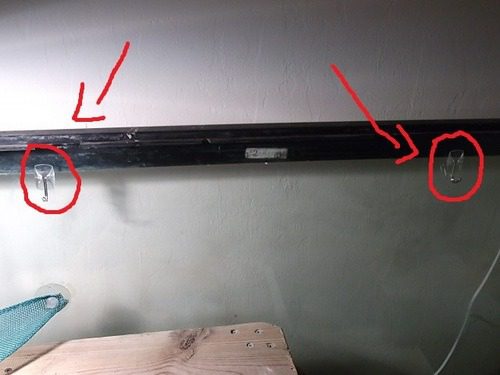To mount a UVB light inside a tank, securely attach the fixture to the interior wall using the provided mounts or suction cups. Ensure the light is facing the enclosure without obstructions.
A properly installed UVB light is essential for maintaining the health of many reptilian and amphibian pets, providing them with vital UVB rays necessary for synthesizing vitamin D3, critical for calcium metabolism. When setting up a terrarium or vivarium, hobbyists must prioritize correct UVB light placement to replicate the natural environment and promote the well-being of their pets.
Selecting the right UVB bulb, understanding the species-specific UVB requirements, and regular maintenance of the lighting system are key aspects to consider for a thriving habitat. Remember to replace UVB bulbs according to the manufacturer’s recommendations, as their effectiveness diminishes over time.

Credit: www.reddit.com
Understanding The Importance Of Uvb Lighting
UVB lighting plays a crucial role in the health of reptiles, mimicking the natural sunlight they would receive in the wild. This light is essential for synthesizing vitamin D3, which in turn helps reptiles to metabolize calcium effectively, preventing bone diseases such as Metabolic Bone Disease (MBD). Choosing a UVB light for your tank involves considering the species you’re housing, as different reptiles have varying UVB requirements.
Ensuring that the UVB bulb is neither too strong nor too weak is pivotal. This is where the UVB Index plays a part – a guideline for the strength and distance at which a UVB light should be placed in relation to your pet. A 10.0 UVB bulb might be too intense for some species, potentially causing harm, while a 5.0 bulb could be just right for a forest-dwelling creature. Aligning the UVB output with your pet’s requirements ensures optimal health benefits.
Assessing The Placement Inside The Tank
Establishing the optimal positioning for UVB coverage within your tank is crucial to ensure your reptilian pets receive the right amount of ultraviolet light. Key factors to consider include the distance between the UVB light and the basking spot, as well as obstacles that might block the light, such as plants or decorations.
The ideal distance for most UVB lights is typically between 12 to 18 inches from where your pet will bask. This proximity allows for adequate UVB exposure without risking harm from overheating or excessive UV rays. Ensuring there are no obstructions between the light and the basking area is essential for uninterrupted UVB access. Additionally, reflecting materials like aluminum can be used to direct the light more efficiently within the tank.
Installing The Uvb Light Fixture
Mounting a UVB light inside your terrarium or tank is critical for the health of reptilian pets. Ensure the fixture is compatible with your enclosure and the UVB bulb’s requirements. Begin by turning off all power to the setup to avoid any electrical hazards. Carefully measure and mark the interior where the light will be positioned. Use appropriate mounting brackets or clips that come with the fixture for a secure installation. Attach these firmly to the enclosure’s wall, ensuring they’re tight and well-adjusted to avoid the light slipping or falling.
Safety is paramount; therefore, all wires should be neatly bundled and secured away from the habitat’s inhabitants to prevent any contact or chewing. It’s highly recommended to use a timer or a controller to regulate the UVB exposure effectively. After mounting, double-check all components for stability before restoring power and testing the light. Regular maintenance and checking the bulb’s condition are crucial for continued effectiveness and safety.
Maintaining And Monitoring Uvb Light
Ensuring proper UVB exposure is crucial for the health of reptiles in captivity. Regular monitoring with a UVB meter can confirm that levels remain within a suitable range. Mark your calendar for routine checks, preferably every month.
Maintenance doesn’t just stop at monitoring. It’s important to keep the UVB light fixture clean from dust and debris that may block the light. Clean the fixture regularly with a soft cloth to maintain optimal performance.
The effectiveness of UVB bulbs diminishes over time, which makes establishing a replacement schedule necessary. Typically, bulbs require changing every 6 to 12 months, regardless of whether they still emit visible light or not. Stay vigilant with this schedule to ensure your pets receive the adequate UVB they need for their wellbeing.
Frequently Asked Questions For How To Mount Uvb Light Inside Tank
Where Should Uvb Light Be Placed?
Place the UVB light above the basking area of your reptile’s enclosure, ideally at a distance specified by the bulb’s manufacturer, ensuring proper UVB exposure.
How Do You Hang Lights In A Reptile Enclosure?
To hang lights in a reptile enclosure, select a suitable fixture and secure it to the enclosure’s lid or side. Ensure the light doesn’t contact the habitat’s interior to prevent burns. Use a timer to maintain a consistent light cycle for your reptile’s health.
How Do You Fit A Uv Light In A Vivarium?
Begin by selecting a UV light appropriate for your vivarium’s size. Secure the UV bulb in a specialized fixture, ensuring it’s placed at the proper distance from the habitat’s inhabitants. Connect the fixture to a power source, and turn on the light to provide essential UV rays.
Can Uvb Light Go Through Aquarium Glass?
UVB light cannot fully penetrate standard aquarium glass; it significantly reduces UVB transmission, protecting aquatic life from potential harm.
Conclusion
Securing your UVB light properly inside your tank ensures the wellbeing of your reptilian friends. Remember, positioning is key for optimal exposure. Embrace the steps shared in this guide for a thriving habitat. Never hesitate to consult a professional for advice on lighting setups specific to your species.
Happy herping!


